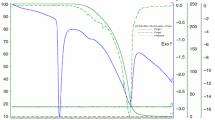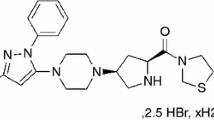Abstract
Ketoconazole (KTZ) is an antifungal agent responsible for the inhibition of 14-α-demethylase sterol. The drug–excipient compatibility studies play an important role in pharmaceutical formulations development. Interactions between drug and excipients may affect the chemical nature, stability, bioavailability and consequently the therapeutic efficacy and safety profile. The main goal of this work was to evaluate the compatibility of KTZ with some excipients: corn starch, microcrystalline cellulose, colloidal silicon dioxide, lactose monohydrate and povidone, using differential scanning calorimetry and thermogravimetry (TG). Binary mixtures in a mass ratio of 1:1 between drug and excipient were used to make the study feasible. The comparison was performed using Tonset of the melt from pure drug and its enthalpy value (ΔHf) with respective values obtained for each binary mixture. Experimental and simulated TG/DTG curves were compared using the Pearson’s correlation coefficients to assess possible incompatibilities due to thermal decomposition of organic matter and/or gaseous products released. Thus, the excipients corn starch and colloidal silicon dioxide have been shown to be incompatible with KTZ.




Similar content being viewed by others
References
Wu Y, Dockendorff C. Synthesis of a novel bicyclic scaffold inspired by the antifungal natural product sordarin. Tetrahedron Lett. 2018;59:3373–6.
Silva P. Farmacologia. 8th ed. Rio de Janeiro: Guanabara Koogan; 2010.
Ishijima H, et al. Simplifungin and valsafungins, antifungal antibiotics of fungal origin. J Org Chem. 2016;81:7373–83.
Karolewicz B, et al. Thermal, spectroscopic, and dissolution studies of ketoconazole-Pluronic F127 system. J Therm Anal Calorim. 2014;115:2487–93.
British Pharmacopeia. The Stationary Office: Pharmacopeia Commission British. London; 2009.
Janssen-Cilag Farmacêutica. Informações importantes sobre a prescrição de Nizoral® comprimidos (cetoconazol), 2006. http://shorturl.at/wyFHZ. Accessed 20 Dec 2018.
Allen LV, Popovich NG, Ansel HC. Ansel’s pharmaceutical dosage forms and drug delivery systems. 9th ed. Baltimore: Lippincott Williams & Wilkins; 2011.
Gil ES, Brandão ALA. Excipientes: Suas aplicações e controle físico-químico. 2nd ed. São Paulo: Pharmabooks; 2007.
Ledeti A, et al. Solid-state preformulation studies of amiodarone hydrochloride. J Therm Anal Calorim. 2016;126:181–7.
Tita D, et al. Compatibility study of the acetylsalicylic acid with different solid dosage form excipients. J Therm Anal Calorim. 2013;112:407–19.
Kunasekaran V, Krishnamoorthy K. Compatibility of rasagiline mesylate with selected excipients for an effective solid lipid nanoparticles formulation. J Pharm Pharm Sci. 2015;7:73–80.
Oliveira GGG, et al. Compatibility study of paracetamol, chlorpheniramine maleate and phenylephrine hydrochloride in physical mixtures. Saudi Pharm J. 2017;25:99–103.
Ghaderi F, et al. Physicochemical evaluation and non-isothermal kinetic study of the drug-excipient interaction between doxepin and lactose. Power Technol. 2015;286:845–55.
Chadha R, Bhandari S. Drug-excipient compatibility screening-role of thermoanalytical and spectroscopic techniques. J Pharm Biomed Anal. 2014;87:82–97.
Freire FD, et al. Compatibility study between chlorpropamide and excipients in their physical mixtures. J Therm Anal Calorim. 2009;97:355–7.
Muthu MS, Feng S. Pharmaceutical stability aspects of nanomedicines. Nanomedicine. 2009;4:857–60.
Matos APS, et al. Compatibility study between diazepam and tablet excipients: infrared spectroscopy and thermal analysis in accelerated stability conditions. J Therm Anal Calorim. 2017;127:1675–83.
Blajovan R, et al. Study of thermal induced excipient–excipient interactions: polyvinyl alcohol and polyvinylpyrrolidone with other pharmaceutical excipients. J Pharm Biomed Anal. 2016;126:171–9.
Vlase G, et al. Study of thermally induced interaction between hydroxyethylcellulose and carboxymethylcellulose with different excipients. J Therm Anal Calorim. 2017;130:397–402.
Silva PCD, et al. Compatibility study between lipoic acid with polymers used in controlled drug release systems. J Therm Anal Calorim. 2016;123:965–71.
Daniel JSP, et al. Risperidone-solid-state characterization and pharmaceutical compatibility using thermal and non-thermal techniques. Thermochim Acta. 2013;568:148–55.
Veronez IP, et al. Characterization and compatibility study of desloratadine. J Therm Anal Calorim. 2014;115:2407–14.
Julio TA, et al. Compatibility of sildenafil citrate and pharmaceutical excipients by thermal analysis and LC–UV. J Therm Anal Calorim. 2013;111:2037–44.
Ding T, et al. Compatibility study of rivaroxaban and its pharmaceutical excipients. J Therm Anal Calorim. 2017;130:1569–73.
Rojek B, Wesolowski M. Compatibility studies of hydrocortisone with excipients using thermogravimetric analysis supported by multivariate statistical analysis. J Therm Anal Calorim. 2017;127:543–53.
Daniel JSP. Eritromicina e Claritromicina: pré-formulação, estabilidade e validação analítica.2018. Tese (Doutorado em Ciências Farmacêuticas)-Faculdade de Ciências Farmacêuticas, Universidade Federal de Alfenas, 2018.
Marciniec B, Kozak M, Dettlaff K. Thermal analysis in evaluation of the radiochemical stability of some fungicidal drugs. J Therm Anal Calorim. 2004;77:305–17.
United States Pharmacopeial Convention. United States Pharmacopeia 32-National Formulary 27. Rockville: United States Pharmacopeial Convention; 2008.
Gomes APD, et al. Development of thermogravimetric method for quantitative determination of ketoconazole. J Therm Anal Calorim. 2008;91:317–21.
Veras FF, et al. Inhibition of filamentous fungi by ketoconazole-functionalized electrospun nanofibers. Eur J Pharm Sci. 2016;84:70–6.
eMolecules. https://www.emolecules.com/ Accessed 26 Sept 2019.
Ali F, et al. Physicochemical characterization and compatibility study of roflumilast with various pharmaceutical excipients. J Therm Anal Calorim. 2017;130:1627–41.
Teleginski LK, et al. Fluconazole-excipient compatibility studies as the first step in the development of a formulation candidate for biowaiver. J Therm Anal Calorim. 2015;120:771–81.
Peres-Filho MJ, et al. Thermoanalytical investigation of olanzapine compatibility with excipients used in solid oral dosage forms. J Therm Anal Calorim. 2011;104:225–60.
Mura P, et al. Compatibility study between ibuproxam and pharmaceutical excipients using differential scanning calorimetry, hot-stage microscopy and scanning electron microscopy. J Pharm Biomed Anal. 1998;18:151–63.
Acknowledgements
The authors would like to thank FAPEMIG, Capes (Case No. 1739641) and CNPq for funding (Grant No. CAG).
Author information
Authors and Affiliations
Corresponding author
Additional information
Publisher's Note
Springer Nature remains neutral with regard to jurisdictional claims in published maps and institutional affiliations.
Electronic supplementary material
Below is the link to the electronic supplementary material.
Fig. S1
Correlation graphs of the blends with (a) microcrystalline cellulose, (b) colloidal silicon dioxide, (c) povidone, (d) lactose monohydrate, (e) corn starch. (TIFF 3805 kb)
Rights and permissions
About this article
Cite this article
Lopes, M.S., Catelani, T.A., Nascimento, A.L.C.S. et al. Ketoconazole: compatibility with pharmaceutical excipients using DSC and TG techniques. J Therm Anal Calorim 141, 1371–1378 (2020). https://doi.org/10.1007/s10973-019-09137-0
Received:
Accepted:
Published:
Issue Date:
DOI: https://doi.org/10.1007/s10973-019-09137-0




